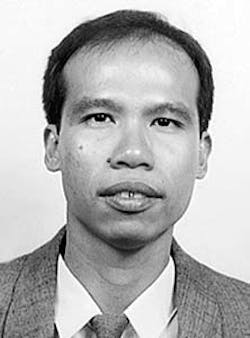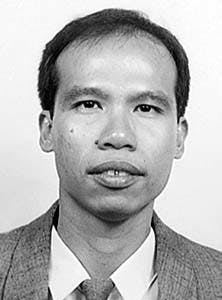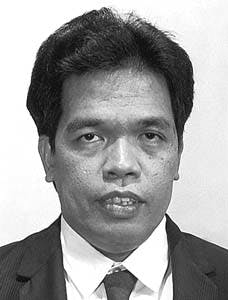Philippine refiner completes diesel desulfurization project
Samuel S. Candido, Elino V. CrisostomoIn anticipation of tightening sulfur specifications on diesel fuel, Petron Corp. built a new 18,000 b/sd gas oil desulfurization unit (GODU) at its refinery in Bataan, Philippines.
Petron Corp.
Manila
The GODU gives Petron sufficient diesel oil desulfurization capacity to meet demand for lower-sulfur diesel in the country.
The project places the refinery in a pacesetter position to comply with the Philippine government's moves to reduce air pollution, especially in urban centers, by reducing the sulfur specification for diesel to 0.5 wt % in 1996 from 0.7 wt % at the start of the project.
Performance tests and initial operations of the unit have revealed a desulfurization efficiency of 91% vs. a guaranteed efficiency of 90%. A feed sulfur content of 1.33 wt % is reduced to 0.12 wt % at normal operating conditions.
Operating difficulties during start-up were minimized through use of a detailed prestartup check conducted during the early stages of construction work. The GODU was designed by Exxon Research & Engineering Co., Florham Park, N.J.
Background
Petron is a government-owned corporation operating under the umbrella of the Philippine National Oil Co. (PNOC). Petron's GODU project was one of two components of PNOC Energy Sector Project, Part A2. The other component was an LPG facilities upgrade.
The PNOC project evolved as a sequel to an energy sector study conducted in 1988 by the International Bank for Reconstruction & Development (IBRD). At that time, IBRD determined that, as a result of the remarkable recovery of the Philippine economy in 1987-1988, the Petron refinery was faced with increasing demand for petroleum products, coupled with tightening product quality specifications and environmental regulations. The study also determined that the refinery's total capacity was limited by specific process units and handling facilities that became bottlenecks during peak production periods.
As a result of these findings, Petron conceived the plan for the GODU project. The basic engineering design package was prepared by Exxon Research & Engineering and its subsidiary, Tonen Technology K.K., Tokyo. Engineering, procurement, and construction (EPC) were done by a consortium of a Japanese trading firm and a Korean EPC contractor.
The project was mechanically complete in April 1995, and was symbolically inaugurated by President Fidel V. Ramos in Malacanang Palace, Manila. President Ramos commended the project as a big boost to the Philippine economy and cited the project's significance in relation to the government's efforts in environmental protection.
In addition, the project shows Petron's strong commitment to the Healthy Air Pact forged between the Philippine government and the country's three oil companies (Pilipinas Shell Petroleum Group, Caltex Philippines Inc., and Petron).
Since commissioning, the GODU has produced products conforming to national diesel specifications. The additional production of desulfurized diesel has supported the Philippines' vision of becoming one of Asia's tiger economies by reducing importation of lower-sulfur diesel.
GODU project
The GODU project included:
- A grassroots 18,000 b/sd gas oil desulfurization unit
- A hydrogen recovery facility (HRF) to separate hydrogen from refinery offgases
- Additional diesel run-down coolers.
Fig. 1 [64864 bytes] is a flow diagram of the Petron Bataan refinery. The new and upgraded units are highlighted.
At the start of the project, Petron's demand projections indicated that, given the market shares of the country's three refineries, total Philippine refining capacity would be tight by 1993. While Petron would meet its share of the market until that time, it could best serve its goal of meeting any shortfall by optimizing its refinery processes and removing any bottlenecks in its downstream processing units, such as the existing gas oil Hydrofiner. These bottlenecks limit the utilization of the crude distillation units.
The installation of a new gas oil desulfurizer and associated units also would enable Petron to fully utilize its available crude capacity and process a cheaper, higher-sulfur crude slate.
Financing, economics
The PNOC Energy Sector Project was financed by IBRD. Only Part A of the loan relates to PNOC-Energy Development Corp. (EDC) and Petron.
The loan agreement between IBRD, PNOC-EDC, and Petron was signed in March 1990. It became effective in June of that year, with an original closing date of Dec. 31, 1994. The loan was later extended to Dec. 31, 1995 to complete both of the projects of PNOC-EDC and Petron.
A definitive cost estimate was made during project planning. Petron determined that the discounted cash flow internal rate of return would be very favorable at 62%, producing a pay-out of less than 2 years. The economics also were satisfactory when subjected to different sensitivity cases, such as 10% increase in investment and maintenance costs.
Project implementation
From the start, refinery management intended to use in-house capabilities to engineer and manage the project from development to completion. Outside engineering consultancy was to be used only when the expertise and experience required were not available from the refinery organization.
Refinery management had a three-fold purpose:
- To make full use of an otherwise untapped wealth of expertise and experience in the organization
- To take advantage of the familiarity of Petron's employees with the refinery facilities, thus producing more practical and suitable process schemes
- To use the project as a fast-track training opportunity to develop young, promising engineers.
The refinery project team, therefore, was a blend of old hands and new faces, headed by a senior refinery manager. The team organization was flexible and dynamic. Any necessary organizational changes were made on a timely basis, depending on the needs of the project phase at hand.
Contracting schemes
The project components were split into two phases:
- Phase 1-study and basic engineering design (Schedule A)
- Phase 2-EPC.
Although the project had several major components, including the LPG facilities upgrade, it was implemented as a single project in order to simplify and shorten the bidding procedure and attract better contractors. Fig. 2 [13463 bytes] shows the project implementation scheme.
Consultancy services for preparation of the Schedule A package for the GODU was negotiated directly with Exxon Research & Engineering. Canada's Stanley Associates Engineering Ltd./
RTM Engineering was engaged for comprehensive review of the entire engineering design package before it was released to EPC contractors for bidding.
Prequalification of the EPC bidders was done in accordance with both IBRD and Petron guidelines. Bidding for the EPC phase was done using a two-envelope, single-submission, two-stage procedure.
The bid specifications for the project included provisions requiring order placement for long-delivery items within 30 days of award. This jump-started project implementation and helped reduce the effects of bidding delays, which will be described later.
EPC
To improve overall stewardship and the ability to make quick decisions, the project management group reported directly to the vice-president/general manager.
The project management group sent a team to the prime contractor's home office to conduct reviews throughout the detailed engineering phase. This saved time and enabled a more-thorough review process. It also allowed the contractor to make timely decisions critical to engineering completion, and sped up procurement activities.
In the critical stages of EPC, monthly coordination meetings were held between key personnel from the contractor and Petron. These meetings took place alternately at the plant site and at the contractor's home office. The meetings served to identify and address problems affecting the project cost and schedule.
Weekly construction coordination meetings also were held at the refinery site to ensure smooth implementation of field activities. The refinery's operations and maintenance departments participated actively in project implementation.
Project delays
The project was completed in 4 years and 11 months, as shown in Fig. 3 [46065 bytes]. Only the EPC phase was completed on time.
A number of difficulties and constraints were encountered in project management (Table 1 [17532 bytes]). These problems accrued a total of 17.5 months delay in the implementation. The major delay was Item 6 in Table 1 [17532 bytes].
Only a few contractors showed significant interest in participating in the project during contractor prequalification. Although PNOC recommended another round of prequalification, the bank decided to use only the initial four prequalified bidders.
During bidding, only a consortium of a Japanese trading firm and Korean EPC contractor submitted a technical proposal. A French contractor decided to back out 1 week before bid opening because of an unfavorable financial situation. Another Korean/Japanese consortium declined to participate because of a heavy workload.
Because only one bidder had participated, PNOC and Petron decided to directly solicit bids from several international contractors. The move was approved by the bank. This, however, resulted in a project delay of 7 months.
New sets of bidding documents were released Jan. 29, 1993, and technical proposals were received May 12, 1993. On June 30, 1993, the commercial proposals were submitted; award recommendations were sent to the Petron board and IBRD on, respectively, July 19 and 22, 1993.
Items 3 and 5 in Table 2 [21264 bytes] consumed a total of 3 months, and were not considered in the original schedule. Item 4 took 6 months to complete vs. the original schedule of 3 months.
The actual negotiation and settling of contract details for the basic design consultancy consumed 2.5 months vs. the original schedule of 1 month. The settlement of legal issues contributed considerably to this delay.
Items 2 and 7 took, respectively, 3 and 2 months vs. the 1 month planned for each item. The main reason for these delays was a change in the bank's handling of staff and monitoring of the project.
Start-up, training
To facilitate the transfer of new technology to Petron's operating personnel, a temporary commissioning and start-up organization was created. The organization was headed by the most senior superintendent in the process technology department.
The start-up organization conducted a detailed, prestart-up check on critical equipment, which minimized operating difficulties during commissioning.
A total of 2,614 man-hr were spent training both the operations and maintenance personnel. Table 2 [21264 bytes] shows the breakdown of the training programs.
Cost analysis
Table 3 [34130 bytes] summarizes project cost vs. the loan allocation for the GODU and LPG upgrade projects. For the foreign component, the estimated expenditures were U.S.$28.146 million vs. the loan allocation of $29 million. This equates to an under-run of $854,000 or 2.9%.
Of the estimated expenditures, only $19.922 million were drawn from the bank. The remaining $9.077 million has yet to be settled, pending resolution of a PNOC request for partial cancellation and payment of the loan.
Although the project has been physically completed, items such as the cost of spare parts and the corresponding duties and taxes have yet to be finalized. The final, actual expenditures, therefore, have yet to be determined.
The local component provided by Petron was more than sufficient to cover all the local expenditures. The total under-run in the local portion amounted to P73.125 million or 22.65% of the local fund allocation. This large under-run was mainly the result of the low bid price of the EPC contractor, which is about 23% lower than the company estimate.
Implementation problems
The contractor's low bid resulted from multisourcing of materials and haggling of prices. For this reason, material sourcing required additional time. This affected reactor agitators, anthracite coals, pipe, fittings, and valves, all of which had to be air freighted to the construction site to meet the commissioning schedule.
During implementation of the project, a number of conflicts arose between the actual conditions and the design. These conflicts resulted in modifications and re-engineering during field construction.
There were many instances of this sort of conflict (piping, internal vessel design, civil works, etc.). These events not only delayed construction but also increased material and labor costs.
The international procurement of major items also caused delivery delays. Because of delays in the arrival of major equipment, a lot of catch-up work was done during the erection and construction phase. Material quality, however, was good and comparable to international standards.
Field construction was done by a local subcontractor. When it became apparent that the construction progress was slow, Petron implemented appropriate construction control and monitoring systems. Because this was done late in the project, it made some work more critical.
As a result of these impediments, Petron had to expend more than the usual number of supervisory man-hours to solve problems.
Recommendations
To improve the management and handling of future projects, the project team identified the following recommendations:
- Carefully prequalify EPC bidders, vendors, and equipment manufacturers.
- Develop detailed design specifications and drawings in simple, easy-to-understand language.
- Review documents to prevent conflicting technical provisions in the design specifications.
- Double-check that the vendor received detailed specifications.
- Check that all communication with the vendor was understood (by checking drawings and confirming orders).
- Monitor progress closely and take corrective action when necessary.
- Thoroughly screen personnel involved in the construction phase, making sure they are particularly knowledgeable in inspection for process design compliance.
- Establish an acceptable security gap between the contractor's bid and the owner's estimate to ensure quality project implementation.
- Also as a result of Petron's experiences during the GODU project, a fact-finding team was formed to fulfill some minimum requirements for the LPG facilities upgrade. This team:
- Checked the accuracy of as-built piping and instrument diagrams
- Collected historical data (inspection reports, vendor data, existing drawings, etc.)
- Surveyed and verified drawings of underground piping and instrument and electrical cabling, where possible.
The efforts of this fact-finding team will minimize if not totally eliminate the conflicts experienced during the GODU project.
Operating results
The GODU was commissioned successfully. It has met the primary objective of providing Petron enough capacity to produce environmentally friendly diesel fuel to meet stricter specifications.
With the GODU in place, Petron is capable of producing marketable diesel fuels with sulfur specification of 0.4 wt %. The net effect of the project, as projected in the 5-year business plan, is zero importation of lower-sulfur diesel.
The performance of the new unit was tested during the early stages of operation. Desulfurization efficiency at 18,000 b/sd throughput exceeded the design desulfurization efficiency of 90%.
The GODU was operated at 91% desulfurization efficiency during the performance test run, producing diesel containing 0.12 wt % sulfur from feed containing 1.33 wt % sulfur. Fig. 4 [21189 bytes] and Table 4 [15760 bytes] show, respectively, the flow diagram and operating performance of the GODU.
The HRF, which supplies high-purity hydrogen to the GODU, was successfully commissioned on Apr. 23, 1995. The HRF is operating at only 50% of the design capacity, because of a shortfall in the availability of hydrogen-rich offgases as the reforming unit catalyst approaches its end-of-run. In addition, the other offgas sources are not being utilized fully, and hydrogen recovery is limited by high concentrations of C4/C5 in the feed gas.
In order to alleviate this problem and sustain the hydrogen requirement of the GODU, the following immediate corrective actions and strategies were identified and implemented:
- The operating temperature of the GODU gas scrubber was set between 105 and 100° F. to maximize C4/C5 condensation. This temperature adjustment, however, is limited by hydrocarbon carryover in the recirculating diethanol amine (DEA), as hydrocarbon carryover will cause foaming of DEA.
- The temperature of the Hydrofiner cold separator drum (another source of HRF feed gas) was reduced to condense the C4/C5 fraction, but the adjustment had little effect.
- Compressor gas from the LPG treater was rerouted to augment the make-up gas requirement and offset the shortfall of HRF capacity.
- A leaking valve that had been diverting about 70,000 scfh of H2-bearing off gases to the fuel gas header was repaired. (Petron found the leak by performing a hydrogen balance.)
- A leak discovered in the air vent of a reinforcing pad was repaired.
- There were no major equipment troubles in the GODU circuit during start-up and the first month of operation. The following minor mechanical problems occurred:
- Severe vibration of a GODU feed-charge pump on the motor side was fixed by pulling the pump motor and balancing it in the maintenance shop.
- Vibration problems in the suction and discharge piping of a compressor were rectified by installing additional pipe supports at the inlet and outlet lines.
- Mechanical seal leaks on a pump were repaired by the vendor.
The HRF is expected to operate at its full capacity after regeneration of the reforming catalyst and improved utilization of offgas sources are complete.
Future projects
Petron's experiences with this project constituted a major step toward engineering and management self-reliance. Refinery management is confident that the company can implement future projects easily using the same basic scheme, and with minimal assistance from foreign consultants.
For this purpose, Petron set up a management team for implementing the expansion projects shown in Table 5 [13112 bytes].
Acknowledgment
The authors wish to thank Petron management and the GODU project management group.
The Authors
Samuel S. Candido is operations supervisor of the utilities section of Petron Corp.'s refinery at Bataan, Philippines. He was process supervisor for the gas oil desulfurization and LPG facilities project, for which he handled detailed engineering design review and project commissioning. He has a BS in chemical engineering from Mapua Institute of Technology.
Elino V. Crisostomo is the process coordinator for Petron's upcoming expansion projects, which include debottlenecking of a distillation unit and addition of a naphtha hydrotreater, catalytic reformer, and auxiliary facilities. He was head of the construction/operation group for the gas oil desulfurization and LPG facilities project. He has a BS in chemical engineering from Adamson University.
Copyright 1997 Oil & Gas Journal. All Rights Reserved.


